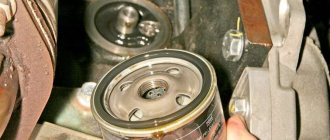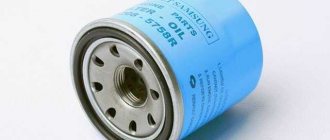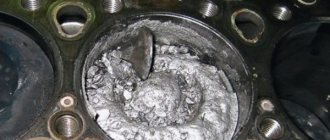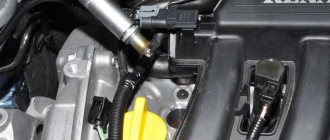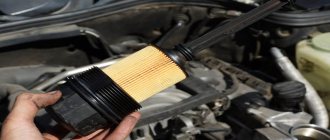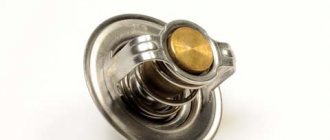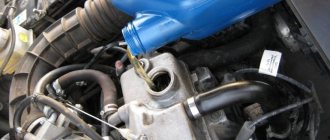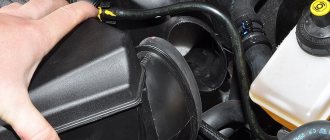Filling volumes and brands of oils and liquids LADA Largus
Lada Largus is a long-awaited car for the Russian market. It is modern, versatile, inexpensive and easy to maintain. The model is built on the long-familiar VO platform. She became one of the most successful and received popular recognition.
The car is available in several modifications - a station wagon and a cargo van with two seats. The manufacturer offers different configurations: from the simplest to the richest, which have everything you need for a comfortable ride. You will have to pay extra for additional options.
Lada Largus is adapted to Russian operating conditions. The car tolerates potholes and other imperfections of the domestic road surface well. The suspension is comfortable and reliable. In addition, the car has durable power plants. If you change consumables in a timely manner, they can serve for a long time and without problems.
The car is equipped with two types of motor. Both of them have the same volume - 1.6 liters, but different power - 84 and 102 horsepower. Owners are also pleased with the low fuel consumption.
The transmission is a five-speed manual gearbox. The option of an automatic rifle was also considered, but it never appeared on sale. The manufacturer claims that the transmission oil does not need to be changed. It is designed for the entire period of operation. But most experts advise filling in new lubricant every 60 thousand kilometers.
About the applicability of oils for Lada Largus
The correct choice of oil is one of the primary tasks that an inexperienced Lada Largus owner involuntarily faces. 16-valve units have a modern and complex gas distribution mechanism design, so the quality and viscosity of the lubricant are very important for them.
Important! Ensuring the proper functioning of the power unit is directly influenced by the qualitative and quantitative indicators of the oil.
The use of low-quality lubricant greatly increases the risk of premature wear of engine components or complete failure of the unit as a whole. If a Lada Largus with a 16-valve engine is under warranty, then the engine oil is changed only using materials recommended by the manufacturer, otherwise the warranty will inevitably be lost.
Regulations
It is not surprising that the frequency of oil changes for the Lada Largus does not differ from the regulations established for the Renault Logan MCV. It averages 10 thousand kilometers, and may vary slightly for better or worse. It all depends on the conditions in which the car is used. If the car is subjected to increased loads, travels on dusty roads, and the owner allows himself to exceed speed and constantly violate traffic rules, then more frequent engine oil changes cannot be avoided. The same applies to adverse weather conditions and poor-quality roads, with which Russian motorists are well familiar. In this regard, the frequency of replacement will have to be reduced to 7-5 thousand kilometers. As you can see, harsh weather conditions and aggressive driving are the main reasons for unpredictable oil changes. Based on this, you need to be more careful and regularly check the condition of the oil.
2283-4-1-0333333333333333
We clean the oil pan from dirt around the drain plug.
We clean the oil pan from dirt around the drain plug.
We clean the oil pan from dirt around the drain plug.
Using a 8-point square, loosen the drain plug. We substitute a wide container for draining used oil with a volume of at least 5 liters. Unscrew the plug by hand and drain the oil.
Attention! Be careful - the oil is hot.
A steel washer is installed under the plug.
Types of oils
- Synthetic is a high-quality oil with continuous advantages. This is a very fluid and liquid composition that is not afraid of low temperatures. An ideal option for any modern vehicle, including Lada Largus. It has good extreme pressure and anti-oxidation properties, and also effectively cools engine components and thereby prevents overheating. Synthetics have proven themselves well in all temperature and road conditions. This oil will last for a long time, and this will have a beneficial effect on the frequency of replacement.
- Semi-synthetic – a mixture of synthetic and mineral oils. There is much more of the latter (70% of the total volume), and yet this composition is much better than “mineral water”. It withstands low temperatures better, as it practically does not freeze in frosty weather. Semi-synthetics are a worthy alternative to mineral oil.
Next, we will consider the best brands, as well as oil parameters, tolerances and standards separately for each year of production of Lada Largus:
Year of manufacture – 2012
- All-season – 10W-40, 10W-50, 15W-40, 5W-40
- Winter – 0W-40, 5W-40, 5W-50
- Summer – 20W-40, 25W-40, 25W-50
- Gasoline engines – SM
- Type – synthetic, semi-synthetic
- The best companies are Shell, Castrol, Mobile, ZIK, Lukoil, Gt-Oil, Valvoline, Xado
Year of release – 2013
- All-season – 10W-50, 15W-40, 5W-40
- Winter – 0W-40, 5W-50
- Summer – 20W-40, 25W-50
- Gasoline engines – SN
- Type – synthetic
- The best brands – Mobile, Castrol, Shell, Xado, Lukoil, ZIK, Gt-Oil, Valvoline
Year of release – 2014
- All-season – 10W-50, 15W-40, 15W-50
- Winter – 0W-40, 0W-50
- Summer – 20W-40, 25W-50
- Gasoline engines – SN
- Type – synthetic
- The best brands are Castrol, Shell, Mobile, ZIK, Xado.
Oil selection table by season (winter, summer)
Oil for VAZ Largus 2012-2014.
| Year | Viscosity SAE all season from +25 to -25 °C | winter from -35 to 0 °C | summer from 0 to +35 °C |
| 0W-40 5W-40 | 20W-40 25W-40 |
| 0W-40 0W-30 5W-40 | 20W-40 25W-40 |
| 0W-40 5W-40 | 20W-40 25W-40 |
+25 to -25 °Cwinter
-35 to 0 °Csummer
from 0 to +35 °CGasoline APIDiesel APITypeRecommended Manufacturers201510W-40 10W-50 15W-40 5W-40
| 0W-40 5W-40 5W-50 | 20W-40 25W-40 25W-50 |
| 0W-40 5W-50 | 20W-40 25W-50 |
| 0W-40 0W-50 | 20W-40 25W-50 |
| 0W-40 0W-50 | 20W-40 25W-50 |
| 0W-50 | 15W-50 20W-50 |
| 0W-50 0W-60 | 15W-50 15W-60 |
Comments
TOP materials
Products in the store
Lada.Online
Lada (“Lada”) is a brand of cars produced by AvtoVAZ JSC. Previously, it was used only for export cars, and for the domestic market, cars were produced under the Zhiguli brand. In 2004, the management of AvtoVAZ announced the transition to the Latin alphabet for the official spelling of the names of all cars produced by the plant: Lada - instead of "VAZ" and "Lada".
Lada.Online is the largest Russian-language automotive resource with a daily audience of thousands, which is dedicated primarily to cars of this brand, the domestic automotive industry and the automotive world in general.
This site is not the official LADA website.
2020 Lada.Online. Copying of material is permitted only with a link to the source.
Source
What oil is recommended for Lada Largus
Let's look at the characteristics of engine oil suitable for Lada Largus.
Generation 1 (2012-2017)
- SAE classification for 1.6 102 liter engine. With. (gasoline, manual, model year – 2015-2017) – 5W-30, 5W-40.
- SAE classification for 1.6 105 liter engine. With. (gasoline, manual, model year – 2012-2016) – 5W-30, 5W-40.
- SAE classification for 1.6 106 liter engine. With. (gasoline, manual, year of manufacture – since 2017) – 5W-30, 5W-40.
- SAE classification for 1.6 84 liter engine. With. (gasoline, manual, model year – 2012-2015) – 5W-30, 5W-40.
- SAE classification for the 1.6 87 hp engine. With. (gasoline, manual, year of manufacture – since 2015) – 5W-30, 5W-40.
Recommended manufacturers of motor oils for Lada Largus: Liqui Molly, Elf Evolution, Lukoil Genesis, Motul.
Source
How much to fill
Lada Largus is equipped with two types of gasoline engines, which require different amounts of oil due to different displacements:
Year of manufacture – since 2012
- For petrol engine 1.6 K7M 87 l. With.:
- How much to fill - 3.3 liters
Year of manufacture – since 2012
- For petrol engine 1.6 16V K4M 105 l. With.:
- How much to fill - 4.8 liters
Let us draw attention to the fact that the specified amount of oil can only be introduced during a complete replacement, which is carried out using special equipment. In other words, such a procedure is only possible at a dealership. At home, Lada Largus owners are content with a partial replacement, during which it is not possible to completely drain the old oil. According to unofficial data, there is a proven method - phased partial replacement. This is no less effective a procedure than a complete replacement at the dealership. At least, it allows you to completely get rid of dirt and remnants of old oil, and then fill in new oil in full (3-3-4.8 liters depending on engine size).
Types of oils
- Synthetic is a high-quality oil with continuous advantages. This is a very fluid and liquid composition that is not afraid of low temperatures. An ideal option for any modern vehicle, including Lada Largus. It has good extreme pressure and anti-oxidation properties, and also effectively cools engine components and thereby prevents overheating. Synthetics have proven themselves well in all temperature and road conditions. This oil will last for a long time, and this will have a beneficial effect on the frequency of replacement.
- Semi-synthetic – a mixture of synthetic and mineral oils. There is much more of the latter (70% of the total volume), and yet this composition is much better than “mineral water”. It withstands low temperatures better, as it practically does not freeze in frosty weather. Semi-synthetics are a worthy alternative to mineral oil.
Next, we will consider the best brands, as well as oil parameters, tolerances and standards separately for each year of production of Lada Largus:
Year of manufacture – 2012
- All-season – 10W-40, 10W-50, 15W-40, 5W-40
- Winter – 0W-40, 5W-40, 5W-50
- Summer – 20W-40, 25W-40, 25W-50
- Gasoline engines – SM
- Type – synthetic, semi-synthetic
- The best companies are Shell, Castrol, Mobile, ZIK, Lukoil, Gt-Oil, Valvoline, Xado
Year of release – 2013
- All-season – 10W-50, 15W-40, 5W-40
- Winter – 0W-40, 5W-50
- Summer – 20W-40, 25W-50
- Gasoline engines – SN
- Type – synthetic
- The best brands – Mobile, Castrol, Shell, Xado, Lukoil, ZIK, Gt-Oil, Valvoline
Year of release – 2014
- All-season – 10W-50, 15W-40, 15W-50
- Winter – 0W-40, 0W-50
- Summer – 20W-40, 25W-50
- Gasoline engines – SN
- Type – synthetic
- The best brands are Castrol, Shell, Mobile, ZIK, Xado.
Tips from Largus owners
Thanks to its unpretentiousness, Lada Largus is able to “work” on any of the oils on the market.
In order for the engine to operate as long as possible, it is necessary to change the lubricant a little more often than indicated in the regulatory documentation - approximately every 8 thousand kilometers. This will allow the lubricant to protect engine parts from excessive wear.
And the market is now simply teeming with proposals, both from well-known brands and from “Chinese” analogues. The main condition is not to fall for a fake, as it can have a detrimental effect on the engine.
In order not to buy a “pig in a poke”, you need to purchase lubricants for Largus only from trusted sellers and avoid cheap offers. If you follow these recommendations, the “goose” motor (as Largus is popularly called) will last a long time.
Tuning the Renault K4M 16 valve engine.
Chip tuning, firmware for K4M 1.6 16 valve engine
An ordinary engine chip, simultaneously with replacing the exhaust with a catless one, can slightly improve the performance of the engine, +\- 120 hp. It's quite possible to get it. This can be supplemented by installing drivetech 10 phase 270 shafts, a little wider than the standard, it will go a little more fun and give a little more hp. To move forward you need to come up with something else.
Compressor for Renault K4M
Exactly like on the K7M or K7J, if you really want, you can attach a PK-23 compressor to the engine and inflate about 140-150 hp. The compression ratio of standard K4M is not too high, it can withstand 0.5 bar. There are no ready-made kits for this engine, but by contacting the manufacturer, they will assemble the required configuration for a specific car. To implement the project, you will need Volga injectors, direct-flow exhaust, phase 270-280 shafts, and to configure all this online you will need an Abit engine control unit.
Turbine for Renault K4M 16 valves
1 in 1 system as with a compressor, only instead of PC-23 we install a TD04 turbine, all nozzles, shafts, etc. we put the same thing. In practice, such configurations produce just over 150 hp. It will be difficult to achieve outstanding dynamic performance, but the fact that the car will go faster is certain. As for the resource... does anyone think about the resource when it comes to supercharging?
Filling volumes and brands of oils and liquids LADA Largus
Lada Largus is a long-awaited car for the Russian market. It is modern, versatile, inexpensive and easy to maintain. The model is built on the long-familiar VO platform. She became one of the most successful and received popular recognition.
The car is available in several modifications - a station wagon and a cargo van with two seats. The manufacturer offers different configurations: from the simplest to the richest, which have everything you need for a comfortable ride. You will have to pay extra for additional options.
Lada Largus is adapted to Russian operating conditions. The car tolerates potholes and other imperfections of the domestic road surface well. The suspension is comfortable and reliable. In addition, the car has durable power plants. If you change consumables in a timely manner, they can serve for a long time and without problems.
The car is equipped with two types of motor. Both of them have the same volume - 1.6 liters, but different power - 84 and 102 horsepower. Owners are also pleased with the low fuel consumption.
The transmission is a five-speed manual gearbox. The option of an automatic rifle was also considered, but it never appeared on sale. The manufacturer claims that the transmission oil does not need to be changed. It is designed for the entire period of operation. But most experts advise filling in new lubricant every 60 thousand kilometers.
Granta liftback dynamics characteristics
Granta with a 106 hp engine. and a manual transmission accelerates to “hundreds” in 11 seconds, and the top speed is 177 km/h. These data correspond to the dynamic characteristics of the sedan, but for less powerful engines the comparison is not in favor of the five-door body, since it is heavier. In the combined driving cycle, the new product consumes from 6.7 to 7.6 liters of 95 gasoline. You can find out all other data from the website https://factik.ru/, including tire size, Granta liftback ground clearance and much more, from the table.
Especially for your convenience, all technical characteristics of the Lada Granta are collected on one page. There are five different combinations of engines and gearboxes, which is why they are presented in this table.
The Lada Granta was originally conceived as a replacement for the “Classic”, which is why engineers did not pursue the dynamism and elegance of the new product. On the contrary, Granta was created to be the most economical, versatile and convenient car at a very modest price.
Technical characteristics of the new Grant:
| Lada Granta Sedan | 1.6 l 8-cl., manual transmission, 87 hp. | 1.6 l 8-cl., manual transmission | 1.6 l 16-cl., manual transmission, 106 hp. | 1.6 l 16-cl., manual transmission | 1.6 l 16-cl., automatic transmission |
| dimensions | |||||
| Length, width, height, mm | 4260 / 1700 / 1500 | ||||
| Wheelbase, mm | 2476 | ||||
| Ground clearance, mm | n/a | ||||
| Front track, mm | 1430 | ||||
| Rear track, mm | 1414 | ||||
| Weight in running order/total, kg | 1115 / 1560 | ||||
| Trunk volume, l | 520 | ||||
| Engine | |||||
| engine's type | four-stroke, gasoline | ||||
| Maximum power, kW/rev. min. | 64 / 5100 | 60 / 5100 | 78 / 5800 | 72 / 5600 | 72 / 5600 |
| Maximum torque, Nm / rev. min. | 140 / 3800 | 132 / 3800 | 145 / 4000 | 145 / 4000 | 145 / 4000 |
| Engine volume, cm3 | 1596 | 1596 | 1596 | 1596 | 1596 |
| Transmission | |||||
| type of drive | Front | ||||
| Gearbox / number of gears | mechanical / 5 | mechanical / 5 | mechanical / 5 | mechanical / 5 | automatic/ 4 |
| Dynamic characteristics | |||||
| Maximum speed, km/h | 167 | 165 | 177 | 172 | 168 |
| Acceleration 0-100 km/h, s | 12,4 | 12,6 | 11,0 | 11,4 | 13,7 |
| Fuel consumption | |||||
| Urban cycle, l/100km | n/a | n/a | n/a | n/a | n/a |
| Extra-urban cycle, l/100km | n/a | n/a | n/a | n/a | n/a |
| Mixed cycle, l/100km | 7,0 | 7,4 | 6,7 | 6,8 | 7,6 |
| Fuel type | unleaded gasoline AI-95 (min) | ||||
| Fuel tank volume, l | 50 | ||||
| Rest | |||||
| Permissible total weight of the towed trailer with/without brakes, kg | 900 / 450 | ||||
| Tires | 175/70 R13 (82, T, H) | 175/65 R14 (82, H); 185/60 R14 (82, N); 185/55 R15 (H, V) | 175/65 R14 (82, H); 185/60 R14 (82, N); 185/55 R15 (H, V) | 175/65 R14 (82, H); 185/60 R14 (82, N); 185/55 R15 (H, V) |
The choice of motorists themselves
The reader has probably already found out what kind of oil to pour into the Lada Largus engine. 6 different options were named. There are other, “less common” substitutions:
- Lukoil Lux Synthetic SN, 5W40;
- SHELL Helix Ultra, 5W40 (many fakes);
- ELF EVOLUTION 900 FT, 0W30;
- TEXACO Havoline Energy, 5W30;
- Nissan Oil, 5W40 (factory option for the Almera sedan);
- GM Dexos 2, 5W30.
By the way, the new name for EVOLUTIONSXR is EVOLUTION 900SXR! You don't look for something that doesn't exist.
ELF EVOLUTION 900 SXR packaging
The question remains, what is the volume of the engine crankcase? Answer:
- The crankcase is designed for 5 liters. oils;
- Filling volume if the filter is not changed – 4.6 liters;
- When changing with a filter, add another 200-250 ml.
Now the reader understands how much oil to pour into the Lada Largus engine, whose 16 valves require as much as 5 liters. lubricants! The filling volume will be less than 5. Read more about the engine models on the Lada Largus in the article: what engines are installed on the Lada Largus.
Analogues of oils for Lada Largus/VAZ 11189
If you ask the dealer what kind of oil is poured into the Lada Largus at the factory, he will most likely say that Lukoil products are most often used. But at one time AvtoVAZ also filled Elf, Shell and other options. Therefore, the car got used to analogues.
Approved analogues by tolerance
Shell Helix HX7 5W-40
4 liter Article: 550021779
4 liters Article: 196256
Tatneft Ultra Optima 5W -30 SL /CF
4 liters Article: 11709
4 liters Article: 162620
What technical fluids are filled from the factory?
The information below was provided by the official LADA website.
Engine oil to the engine
:
ROSNEFT MAGNUM MAXTEC 5W-40 STO 44918199-091-2017 synthetics.
Transmission oil in the gearbox (gearbox)
:
- for manual transmission 2180: ROSNEFT KINETIC MT 75W-85 STO 44918199-083-2017 semi-synthetic,
- for manual transmission JH3, JR5: TRANSELF TRT 75W-80 TPM4501/B06138A synthetics.
Coolant (antifreeze)
:
Coolstream NRC yellow.
It is unknown what kind of oil is in the power steering from the factory; Mobil ATF is used when topping up and replacing.
Attention! This information is for reference only and may be changed by AvtoVAZ without prior notice to the Buyer. For information on recommended working and lubricating fluids, we recommend contacting an official LADA dealer
Other background information on Lada Largus is provided here.
Found an error? Select it and press Ctrl+Enter..
Quantity of technical fluids and fuel oils in Lada Largus
| Filling/lubrication point | Filling volume, liters | Name of oil/liquid | |
| Fuel tank | 50 | Motor gasoline not lower than AI-95 | |
| Engine lubrication system | K7M | 3,3 | Motor oils with API quality class: SL; SM and SAE viscosity level: 5W30; 5W40; 5W50; 0W30; 0W40 (standard oil from AVTOVAZ - “Shell PC 1021”) |
| K4M | 4,8 | ||
| 11189 21129 | 4,1 | ||
| Engine cooling system | 6 | Antifreeze GLACEOL RX (type D) (standard Renault), CoolStream NRC (standard AVTOVAZ), or analogues | |
| Transmission | JH3 | 2,8 | Transmission oils: API quality class: GL-4; GL-5 and SAE viscosity level: 75W80 (standard oil from AVTOVAZ - “ELF TPM 4501”) |
| JR5 | 2,5 | ||
| 21809 | 2,25 | ||
| Power steering | 1 | Power steering fluid (oil) Mobil ATF 52475 (standard), or ELFMATIC G3 | |
| Gearbox control mechanism | — | MOLYKOTE 33 “MEDIUM” lubricant | |
| Air conditioning refrigerant | 475 ± 35 g | Freon R134a (standard from AVTOVAZ - “Arkema”) | |
| Air Conditioning Compressor Oil | 135 ± 10 g. | Sanden SP-10 | |
| Front wheel drive joints (CV joints) | — | MOBIL CVJ 825 BLACK STAR or MOBIL EXF57C grease |
1
votes: average:
5,00
out of 5)
Loading…
How to replace the oil filter
You will need: a 10" or 13" wrench, a puller or a screwdriver.
On the K4M engine, access to the oil filter is blocked by the engine protection, which will have to be removed (6 x 10 screws). Or remove the fuel frame protection from above by unscrewing the 2 “13” screws. Place an empty container under the filter and turn it counterclockwise using a puller.
If you don’t have a special tool, you can use a screwdriver. For easier access to the filter on the K7M engine, you can remove the exhaust manifold thermal shield by unscrewing the three mounting screws. Then pierce the filter housing with a screwdriver (closer to the bottom of the filter, so as not to damage the motor fitting), unscrew the filter, using the screwdriver as a lever.
Fill the new filter 1/3 full with new engine oil and lubricate the sealing ring with it. Then install the oil filter, tightening it by hand until the O-ring comes into contact with the cylinder block. After this, tighten the oil filter another 3/4 turn.
Tools and materials
Initially, we will stock up on the necessary set of tools and devices. Here you will need:
- new lubricant with appropriate parameters and filter;
- 4-sided “8” key, as well as a set of regular sockets with a knob;
- Rags and containers in which the waste will be collected.
Before direct replacement, the motor should be warmed up. The best measure would be to drive instead of reaching operating temperature by idling the engine without load.
All information on choosing engine oil for Lada Largus
When the production of K4M motors was localized, the plant was first supplied with one material - SHELL PC 1448, 0W30. Then barrels with another material were noticed - LUKOIL Genesis RN 5W40. According to official information, the engine is filled with ELF SOLARIS RNX oil. The latter belongs to the 5W30 class.
The most expensive material for refilling K4M
By analyzing all the information, you can choose which oil to pour into the Lada Largus engine with 16 valves. Are there any other options:
- Before localization, it was stated that K4M engines were filled with SHELL PC 1021 oil (viscosity was not specified);
- Answer received from the support service: the first filling material for all Largus engines is ELF EXCELLIUM NF 5W40 oil. The date of receipt of the response is December 2, 2014.
So there are five different brands named here. And all this is the first refueling!
Renault company recommendations (motor oil regulations)
It's no secret that the Lada Largus is a redesigned Renault Logan station wagon. When buying a Renault car, everything looks simpler than with Largus:
- From the factory, the K4M engine is filled with ELF Excellium LDX oil. Its viscosity is 5W40 (not 5W30);
- When replacing, the material ELFEvolutionSXR with a viscosity of 5W40 would be recommended. 5W30 is for 8 valves.
After warming up, oil with the index “W30” will be less viscous than “W40”. And for hydraulic compensators you need just the second one.
You can follow Reno's recommendations and everything will be fine.
Subtotal
All options for “factory” refueling:
- SHELL: brand PC 1448 (0W30), PC 1021 (presumably 0W30);
- ELF: brand SOLARIS RNX (5W30), EXCELLIUM NF (5W40), EVOLUTION SXR (5W40);
- Russian industry: LUKOIL GENESIS RN (5W40).
Renault company recommendations (for replacement): ELF EVOLUTION SXR (5W40).
What kind of oil does VAZ recommend for a 16-valve valve?
Let's see what they say in the instruction manual. Brands and marks are not named here.
Instructions for Lada Largus
Only viscosity classes are given, as well as quality classes and ash content (ACEA).
The list does not include 0W50 viscosity grade. Materials that meet such high requirements simply do not exist. The quality classes indicated are standard, and the “best” of them is API SN. Well, the “ash content” should be “medium” - all ACEA class names begin with the letter A.
The choice of motorists themselves
The reader has probably already found out what kind of oil to pour into the Lada Largus engine. Six different options were named. There are other, “less standard” replacements:
- Lukoil Lux Synthetic SN, 5W40;
- SHELL Helix Ultra, 5W40 (many fakes);
- ELF EVOLUTION 900 FT, 0W30;
- TEXACO Havoline Energy, 5W30;
- Nissan Oil, 5W40 (factory option for the Almera sedan);
- GM Dexos 2, 5W30.
By the way, the new name for the EVOLUTION SXR is EVOLUTION 900 SXR! Don't look for something that doesn't exist.
ELF EVOLUTION 900 SXR packaging
The question remains, what is the volume of the engine crankcase? Answer:
- The crankcase is designed for 5 liters of oil;
- Filling volume if the filter is not changed – 4.6 liters;
- When replacing with a filter, add another 200-250 ml.
Now the reader knows how much oil to pour into the Lada Largus engine, whose 16 valves require as much as 5 liters of lubricant! The refueling volume will be less than 5. Read more about the engine models on the Lada Largus in the article: what engines are installed on the Lada Largus.
How to change oil correctly on LADA GRANTA
Previously, I wrote an article about which engine oil to choose for Lada Granta.
And also about what requirements the manufacturer (AvtoVAZ) has for motor oils. If you haven't read it yet, watch it here! By the way, Lada Granta
is still the best-selling car brand in Russia.
Over 9 months of 2022, even during the pandemic, over 61,000 units were sold. cars of the Lada Granta
.
For those interested, the TOP 10 best-selling cars are as follows (the number of cars sold and the percentage of sales decline compared to the same period in 2022 are indicated)
So, how should you properly change your engine oil?
The most important thing, and I will not tire of repeating this, is to observe the correct replacement interval.
Oddly enough, the instruction manual does not write about such concepts as heavy duty operation
and
reduced engine oil change intervals.
They write 15,000 km and that’s it!
And then car owners crowd around the service stations, writing negative reviews about the oil they filled in and how the engines were decarbonized. And what is very profitable, in my opinion, is purely business in Russian.
That's sorted out.
Always change the oil filter along with the engine oil.
I’m sure that everyone already knows about this; in extreme cases, the service center should definitely remind you about it. But still. I had to write about this.
An important question: before changing the oil, do you need to flush the engine and how to do it?
During engine operation, engine oil undergoes the following negative changes:
the oil gradually oxidizes (this is facilitated by high temperatures, pressure, oxygen contained in the air and the resulting oxidation products). Anti-oxidation additives slow down this process.
the oil gradually becomes contaminated because it cleanses the engine of oxidation products, water, dust and engine wear products. Detergent additives (detergents) and dispersant additives work here, which prevent these contaminants from becoming larger.
When flushing is needed:
1.
If the recommended oil change interval is exceeded. When the additives in the oil have already been “spent” during operation, and operation is still ongoing, then oxidation products are freely formed, enlarged and deposited wherever possible. Moreover, this can happen uncontrollably and like an avalanche!
Therefore, when the recommended replacement interval is not followed. You need to wash off all these dirt and deposits before it’s too late.
2.
Also, if you buy a used car and don’t know how often the engine oil has actually been changed, it’s better to flush the engine!
3.
If there were any negative interferences in the normal operation of the engine (filling in the wrong oil, filling in incompatible oil, etc.)
In all other cases, flushing is not required and does not need to be done before each oil change if you operate the car correctly! Many service providers simply want to make money on an additional procedure.
Flushing oil consists only of base oil and detergent-dispersant additive. You cannot drive on flushing oil! The used oil is drained, flushing oil is added in the amount of the recommended volume of engine oil (for Lada Granta with manual transmission 3.2 l, with automatic transmission 4.4 l). Flushing is carried out at idle speed without load. The washing time is indicated by the manufacturers on the labels. Then the flushing oil is drained, the oil filter is replaced with a new one, and fresh engine oil is added. Flushing in cans (5 minutes, 10 minutes, etc.) is a concentrate of detergent-dispersant additive added directly to used oil before changing. Packaging volume is usually from 300 to 500 ml. Flushing is also carried out at idle speed without load. The washing time is indicated by the manufacturers on the labels. Then the used oil is drained, the oil filter is replaced with a new one, and fresh engine oil is added. Flushing with engine oil that you plan to fill in for operating the car. In my opinion this is the most preferable method. At the same time, this is also the most expensive method of washing, because... Motor oil costs more than any flush. But it is justified, because after flushing there is always some amount of the flushing component left in the engine and it is not known how it will react with the engine oil. And in this case, both engine flushing and operation take place using the same product. Plus, you can continue to use engine oil and change it after 1000-2000 km. During this period, the engine oil will wash away even old deposits
Important! The filter is changed with every engine oil change.
Make the right choice! Not a nail or a rod on your roads!
Changing engine oil in Largus
We drive the Lada Largus car onto the overpass or hang it out using a lifting device. It would also be a good idea to use a pit. We dismantle the engine crankcase protection and clean the sump itself from any dirt present on its surface. We open the hood and find a plug on the filler hole. We unscrew it. We move under the pan and loosen the tightening torque of the drain plug. Now we place a pre-selected container at the drainage site and completely unscrew the plug. We recommend working with gloves so as not to burn your hands with heated drilling. We watch the old oil drain for several minutes until the last drops “leave” the pan. We look at the condition of the sealing ring of the plug and, if it is damaged, replace it with a new element. Then you can unscrew the filter. As a rule, it “yields” to manual effort. Sometimes there are situations with the filter housing “stuck” to the block. Here a puller or a regular screwdriver comes to the rescue, with which the body of the component is pierced, after which the filter is unscrewed using the newly created conditional lever. Before installation, fill the new filter with lubricant, and lubricate the rubber seal around the perimeter of the contact area. After installing the new filter element and tightening the plug on the drain hole, you can begin to fill in new lubricant. Let us remember that the volume of oil required by a 16-valve engine is 4.8 liters. It is not recommended to exceed this limit, since there is a risk of the seals being squeezed out by excess pressure while the unit is running. Upon completion of filling, install the plug in place. We take a 10-minute break and return to the engine again to check the level of new oil. We do this using a probe with marks “min” “max”
It is important to reach the level located exactly between these marks. We start the unit and check the lubricant pressure lamp
It should go out 5 seconds after the engine starts. We turn off the Lada Largus engine. Now is the time to check the motor for lubricant leaks. If such a fact is present on the filter or drain plug, then we eliminate it by tightening it.
What kind of oil to fill in Lada Largus 8 valves K7M
8-valve models are not so capricious. The manufacturer even allows the oil filter to be replaced not every time the lubricant is changed (but this cannot be done with a 16-valve engine). If we talk about recommended lubricants, you can also use Elf SOLARIS FE 5W-30 and Lukoil Genesis Armortech 5W-40. But there are several other options that are filled into 8-valve engines in Renault.
Elf EXCELLIUM NF 5W-40
4 liters Article: 156335
Elf Evolution 900 SXR 5W-30
5 liters Article: 194839
Articles (must read!)
The plug is unscrewed from the bottom of the crankcase. It is supplied with a washer. These parts are not sold as a set, only individually.
Drain plug and washer
The article number of the plug is 7703075348. We were able to find three articles for the washer: 110265505R, 8200641648, 7703062062. In the latter case, it will just be a copper ring.
The washer can be made from a sheet of copper. The internal diameter should be 16.7 mm. If the dipstick is lost, it’s not a problem. Use article number 8200666287.
Selection of analogues
Firstly, the drain plug has alternative part numbers - 7703075210, 7703075347, 7903075033. Analogs for it:
- CORTECO 220100S
- BMW 07119919143
- METALCAUCHO 05655 or 00667
- SASIC 1630210
- NISSAN 1112800Q0A or 1112800QAA
- ASAM 80102 or 30385
- CITROEN 16393 or 2221 11
- OPEL 4433916 or 4418098
- FEBI 45890
- FA1 539.970.011 or 518.471.001
The washer with a rubber band also has analogues:
- GECKO GKFLM507
- SASIC 1640540 or 4001073
- DELLO 3011020655005R
- CITROEN 16488
- VICTORREINZ 703376900
- MANOVER MRLOGAN8853 or MRLOGAN7612
- CORTECO 006339S
- PPS 21431867
- FEBI 44793
- DT 2.10221
- AJUSA 502300
- VAICO V460562
- MERCEDES-BENZ
- SCANTECH 5321867
Filter part numbers can be found in other text.
When to check the oil condition
Naturally, not every motorist wants to check the condition of the oil frequently. And yet, this will have to be done, given the difficult Russian operating conditions. As you know, they check the oil using a dipstick - they pull it out, then look at the color of the liquid, then evaluate its smell and contents. Any deviations may be a reason for an urgent oil change. Among these deviations, we highlight darkening, a specific smell, the presence of sediment in the form of mud deposits, metal shavings, etc. Let us note a few more signs that indirectly indicate that it is necessary to urgently check the oil and, if necessary, replace it:
- Sudden loss of engine power
- The motor is not able to develop high speeds
- Excessive fuel consumption
- High engine oil consumption
- Noise and vibration, which are even greater under increased loads and at high speeds
- There is a noticeable delay when upshifting or downshifting.
What to look for when choosing
Before pouring oil into the Lada Largus, you need to remember that no matter what lubricant is used, there is no fundamental difference in the number of valves - it “works” equally well on both engine options.
Therefore, first of all, it is necessary to decide on the composition. This definition depends on the operating mode of Largus. If the car will be used daily, then it is worth pouring into such a car oil created on the basis of conventional or hard hydrocracking.
In simple terms, we are talking about synthetic lubricant and semi-synthetic lubricant, respectively. You can also use mineral oil, but you will have to change it more often.
If Lada Largus is driven at high speeds, then it is necessary to use lubricants based on esters or PAO. As for mineral oils, they are completely unsuitable for such operating modes.
Stages of replacing lubricant Lada Largus
Changing engine oil on this model occurs like on most cars. The main rule is to use the lubricant recommended by the manufacturer. Or purchase analogues that meet the required tolerances.
Lada Largus cars, as well as cross modifications, are equipped with 1.6-liter gasoline engines:
- 8 valves - K7M (VAZ-11189);
- 16 valves - K4M (VAZ-21129).
The replacement process for these engines and modifications will be the same. But we will make a reservation that the described instructions are carried out on a car with a 1.6l VAZ engine. 16 valves.
Draining waste fluid
To drain oil from a Lada Largus, it is desirable to have a pit or overpass, since the main actions will take place from below the car. Therefore, we place the car above the technological ditch, go down into it and remove the engine protection from below. To do this, you need to unscrew the 6 bolts under the head by 10mm.
When everything is ready, we proceed directly to the drain:
- Raise the hood, then find the filler neck on the engine and unscrew the plug (Fig. 1).
To unscrew the filter element, it is advisable to have a special puller. If it is not available, you can try to unscrew the filter using improvised means. For these purposes, you can use, for example, an old alternator belt, a regular belt, a bicycle chain or a simple screwdriver.
This method will allow you to drain as much of the used oil as possible, after which you can proceed to further actions. The main thing is not to forget, everything that we unscrewed must be put back in place.
Flushing the lubrication system
Engine flushing on a Lada Largus car should be carried out only in exceptional cases, which include:
- Purchasing a used car when you cannot be sure of the quality and regularity of lubricant replacements.
- During operation, the service replacement interval was repeatedly exceeded.
- Engine operation with constant frequent overheating, which contributes to coking and other deposits.
- In cases of switching to another type, for example from synthetics to semi-synthetics.
There are several types of flushes for the Lada Largus engine:
- Five- or seven-minute, capable of cleaning even the most difficult deposits. They must be used very carefully and strictly follow the instructions printed on the packaging. It is recommended to use them only when absolutely necessary. Since there is a high probability of causing premature wear of the sealing seals. And also clog the oil channels with particles of washed away carbon deposits.
- Special compounds that are added to the oil several hundred kilometers before the expected change. They are more gentle, but there is also a possibility of clogging of the oil channels.
- Flushing oil is the most gentle method of cleaning the engine from the inside. This composition is poured after draining the waste, the engine runs for 15-20 minutes, after which the liquid with deposits is drained. The absence of aggressive additives in the wash composition gently cleans the engine, but is not able to remove heavy contaminants.
- Regular oil that you are going to use when changing. This method is not so popular due to its high cost.
Installing a filter, filling in new engine fluid
If the Lada Largus lubrication system is sealed and does not require repair work to eliminate leaks, you can proceed to adding fresh oil. In addition to the oil itself, we will need a new gasket-washer for the drain plug 21080101106200. As well as the original Livna oil filter 2108-1012005-08. But recently, dealers have begun installing LADA 2105-1012005-82 filters.
When everything is ready, let's move on to the bay:
- Replace the drain plug with a new washer.
- We tighten and put the oil filter in place. Pre-lubricate the rubber sealing ring with fresh oil.
- Pour new oil into the filler neck.
- We check the level on the dipstick; it should be between the MIN and MAX marks.
- We start the engine, let it run for 10-15 seconds, then turn it off.
- After 5 minutes, check the level with a dipstick and top up if necessary.
Why can the oil level in a Largus engine change?
Sooner or later, every car owner may face the problem of decreasing engine oil level. There are several reasons for this phenomenon:
- natural oil consumption;
- reducing its quantity due to leaks.
In the first case, the problem may appear after 150 thousand kilometers on Lada engines. As the piston rings and valve stem seals wear out, lubricant enters the cylinders and begins to burn along with the fuel. In this case, appropriate engine repairs with replacement of faulty elements will help.
Leaks appear due to wear of the oil seals of the moving parts - typical for all four engines. But VAZ engines are also characterized by gasket leaks, which are absent in Renault.


